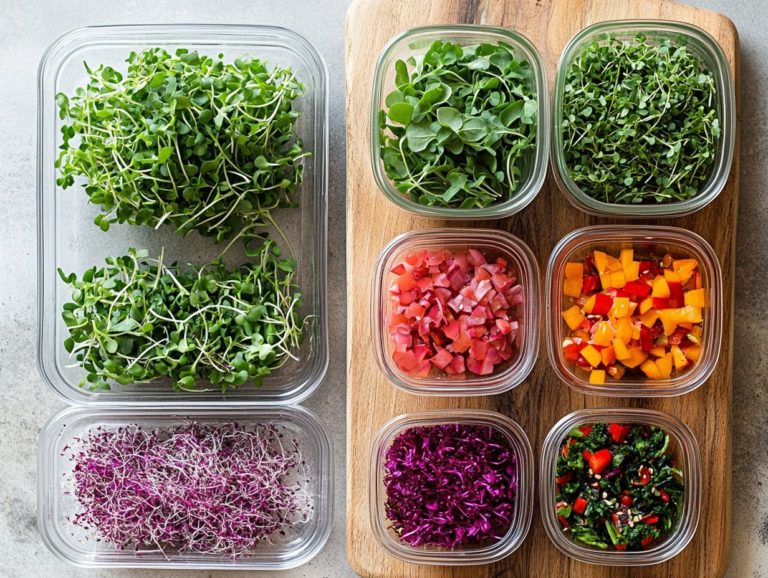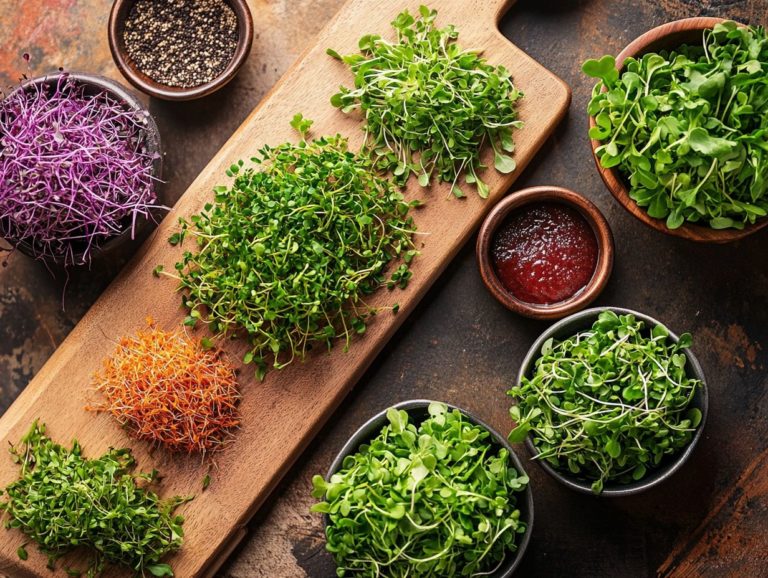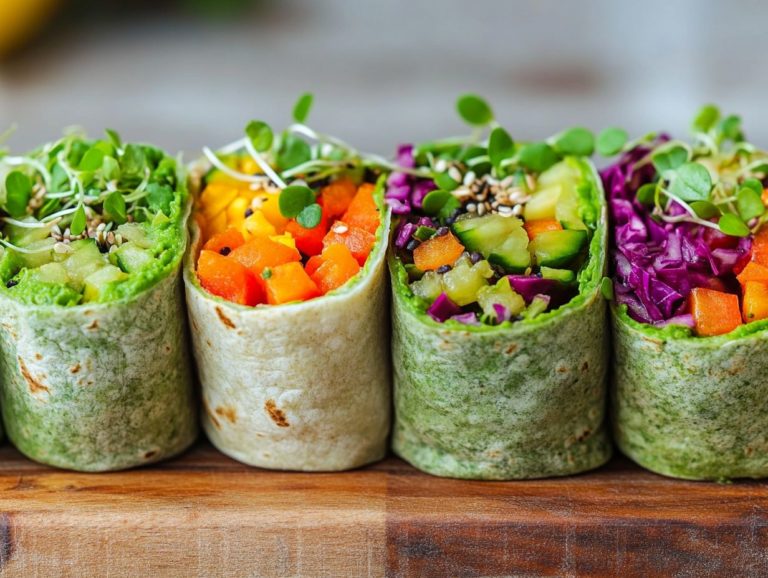6. How to Create Microgreen Garnishes
Microgreens are far more than just a fleeting trend; they offer a bright flavor, color, and nutrition that can truly elevate your culinary creations.
Dive into the world of microgreens and discover why they are the ideal garnish for your dishes. Learn how to select and prepare these petite greens, explore popular varieties along with their distinctive uses, and gather tips for captivating presentations.
Let your imagination run wild as you find inspiration for incorporating microgreen garnishes across diverse cuisines, transforming your meals into impressive masterpieces. Get ready to wow your guests!
Contents
Key Takeaways:
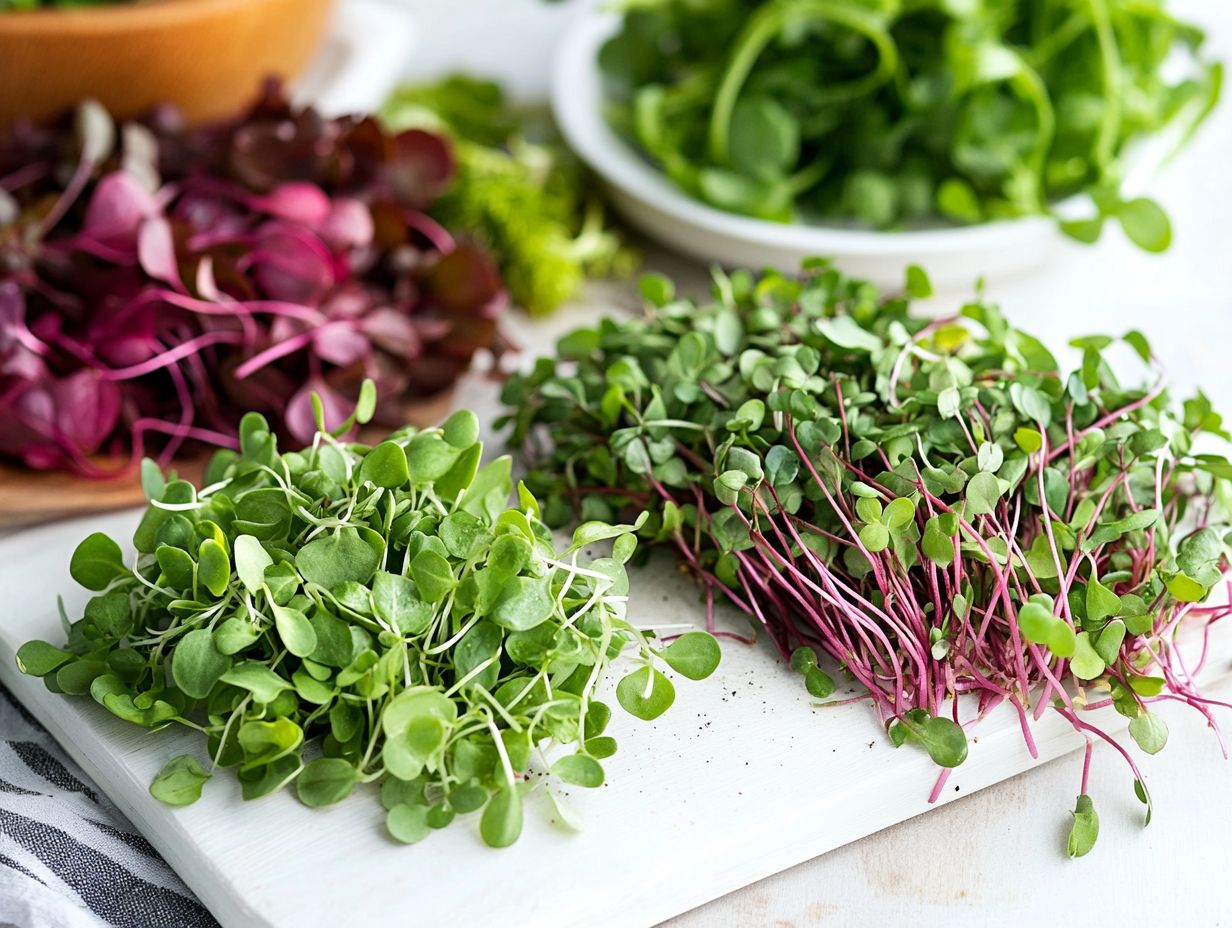
- Microgreens are young, edible plants that add flavor, nutrition, and visual appeal to dishes.
- Microgreens make great garnishes due to their stunning colors, delicate textures, and versatile flavors.
- Select, clean, and store microgreens carefully to ensure freshness and safety for use as garnishes.
What are Microgreens?
Microgreens are those delightful, tiny plants you can harvest just after their first true leaves have emerged. They pack a punch of nutrients and vibrant flavors that can elevate a variety of dishes. Think of arugula, cilantro, and basil these miniature greens are not only brimming with vitamins and minerals, but they also introduce a fresh and unique flavor profile to your culinary creations.
As microgreens become popular, knowing their health benefits can enhance your cooking experience.
Typically, microgreens are grown in soil or by growing plants without soil and journey through stages like germination, seedling, and maturation, often ready for your kitchen within just 7 to 21 days. Their stunning colors and delightful textures make them perfect for garnishing salads, soups, and sandwiches, showcasing a delightful range of tastes from peppery to sweet.
By incorporating microgreens into your meals, you not only elevate the flavor profiles but also give your nutrition a hefty boost. Some studies even suggest that these tiny greens can contain up to 40 times more key nutrients than their mature counterparts.
So, whether you’re experimenting with fresh microgreens recipes or using them as a cooking technique across various cuisines, adding these nutrient-dense greens to your diet offers a delightful and health-conscious enhancement.
Why Use Microgreens as Garnishes?
Using microgreens as garnishes not only enhances the visual appeal of your dishes but also elevates their flavor profile, adding a fresh and zesty touch that beautifully complements various cuisines. These vibrant greens can transform a simple salad into a gourmet experience, making them perfect for everything from soups and tacos to sandwiches and smoothies.
With a diverse range of flavors at your fingertips think the peppery notes of mustard greens or the subtle sweetness of pea shoots you have the freedom to experiment creatively and elevate your culinary presentations.
Incorporating microgreens also brings a nutritional boost to your meals. These tiny plants are brimming with vitamins and antioxidants, making every dish not just more inviting but also healthier. For example, the bright green radish microgreens provide a delightful crunch that pairs wonderfully with roasted meats or fish, while the delicate basil microgreens can elevate your pasta dishes with their aromatic essence.
Whether you scatter them atop a vibrant avocado toast or layer them between ingredients in a gourmet burger, these petite garnishes enrich not only the aesthetic but also the overall sensory experience. They invite diners to indulge in a feast for both the eyes and the palate.
Choosing and Preparing Microgreens
Choosing and preparing microgreens requires a nuanced understanding of their distinct growth needs, selecting the perfect varieties, and implementing effective cleaning techniques to guarantee they are safe and delightful for your table.
With a plethora of microgreens available think sunflower seeds, wheatgrass, and basil each variety thrives under its own set of conditions. It s crucial for you to identify which ones harmonize best with your home gardening setup.
Once you’ve harvested them, mastering proper cleaning and storage techniques becomes essential to preserve their freshness and nutritional value, enabling you to savor their benefits in an array of exquisite microgreen recipes.
Selection Criteria
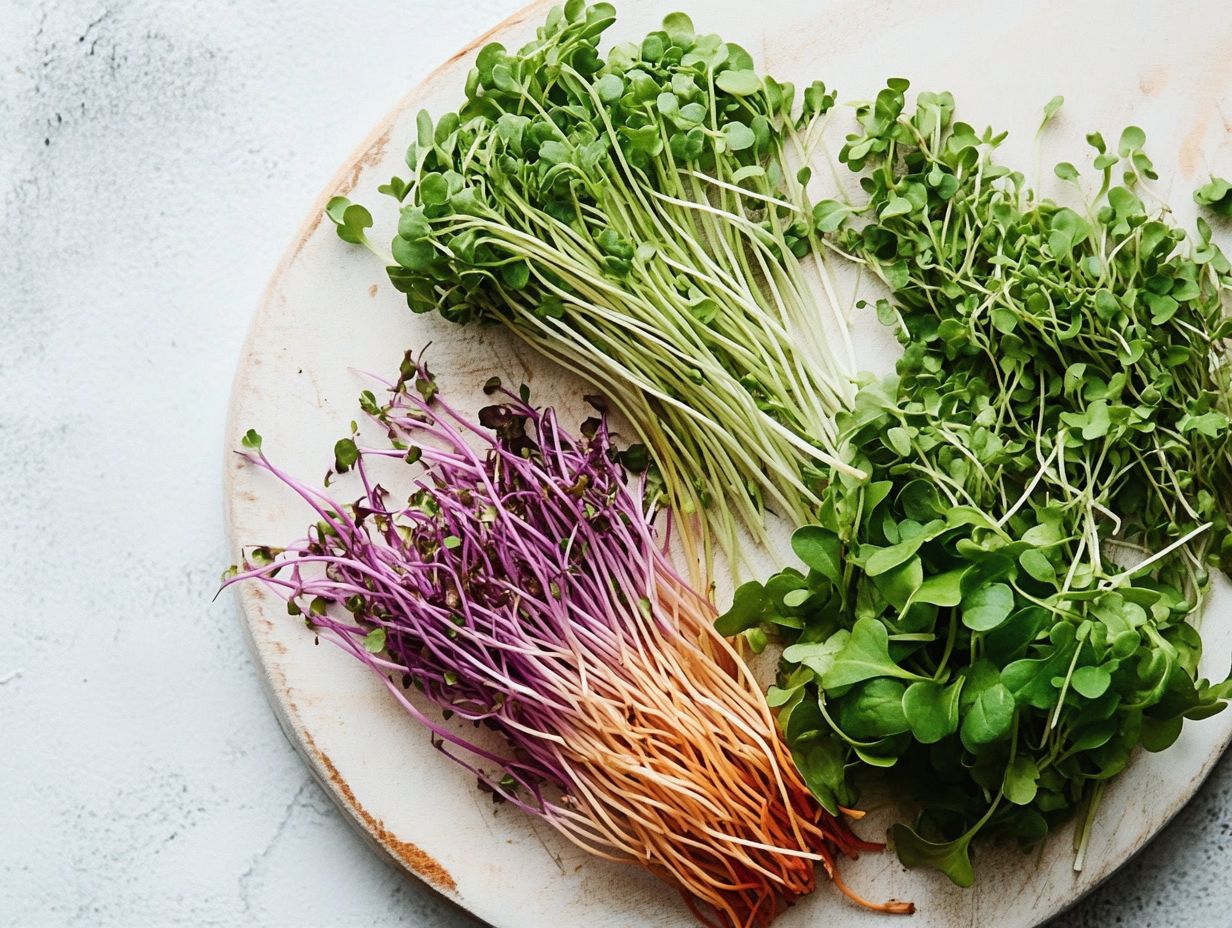
When selecting microgreens, consider factors such as flavor, texture, and nutritional content, as these elements can significantly enhance your overall dish. Choices like cilantro, arugula, and mustard not only deliver distinct flavors but also introduce unique textures that elevate salads, wraps, and sandwiches.
Exploring the diverse flavors of microgreens gives you the power to pair them thoughtfully with various ingredients. This careful pairing elevates your culinary creations.
Beyond the basics, it’s crucial to recognize that different microgreens boast varying levels of vitamins and minerals, making some particularly advantageous for specific dietary needs. For example, broccoli microgreens are celebrated for their high antioxidant content, while pea shoots offer a delightful sweetness.
Understanding how these versatile greens can complement a wide array of dishes from garnishing soups to shining as the star topping on gourmet pizzas unlocks a new realm of culinary possibilities. Experimenting with these tiny powerhouses not only enhances the visual appeal of your meals but also maximizes their health benefits.
Cleaning and Storing Techniques
Proper cleaning and storing techniques for microgreens are essential to maintaining their freshness and preventing spoilage, ensuring you always have high-quality greens at your fingertips for your culinary creations.
These vibrant, nutrient-rich plants bring a delightful array of flavors and health benefits, making them an irresistible addition to your dishes. After rinsing, take a moment to gently pat them dry; this simple step minimizes moisture that could lead to decay. For the best storage, tuck them into the refrigerator’s crisper drawer, where they’ll stay fresh and crisp!
Follow these best practices to extend the life of your microgreens and enhance your meals’ flavors, allowing you to fully enjoy the nutritional rewards they provide.
Types of Microgreen Garnishes
Microgreens garnishes present an impressive array of types, each bringing distinct flavors and visual allure that elevate countless dishes, making them an essential addition to your culinary repertoire.
Whether you re attracted to the soft leaves of pea shoots, the striking greens of sunflower, or the bold kick of mustard, there’s a microgreen perfectly tailored to every culinary style and taste preference.
By exploring the diverse varieties of microgreens, you can seamlessly integrate them into your cooking, transforming straightforward meals into exquisite dining experiences.
Popular Varieties and Their Uses
Popular microgreens like cilantro, basil, and pea shoots each bring their own distinct characteristics and flavors to the table, making them perfect for a range of culinary applications. For example, cilantro is a natural fit for salsas and guacamole, while basil elevates microgreens pesto and dressing to new heights.
Pea shoots, on the other hand, add a delightful crunch and a hint of sweetness, enhancing salads, tacos, and wraps. This showcases the remarkable versatility of microgreens, serving as both garnishes and essential ingredients.
Beyond these favorites, consider other microgreens like radish, arugula, and mustard greens, each offering their own unique tastes and textures to enrich your culinary creativity. Radish microgreens, with their peppery bite, can elevate sandwiches, while arugula s slight bitterness pairs wonderfully with grain bowls.
Mustard greens, boasting a robust flavor, can invigorate stir-fries or soups, transforming them into not just garnishes but key components that enhance the overall taste experience.
As you experiment with these vibrant additions, the possibilities are endless, allowing you to turn everyday meals into gourmet delights.
Tips for Creating Beautiful Garnishes
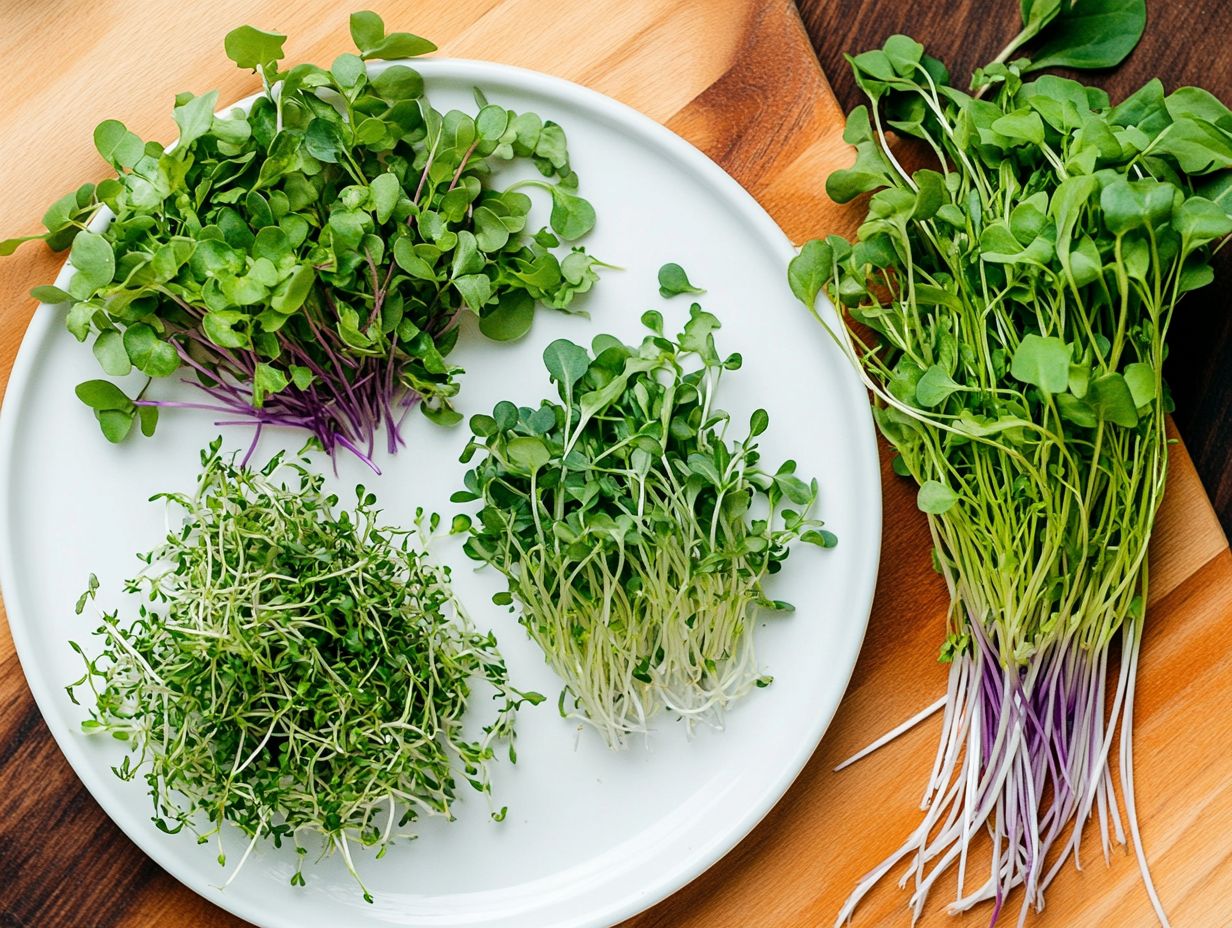
Creating exquisite garnishes with microgreens demands a good eye for presentation, meticulous layering, and a dash of creativity to elevate your dishes.
By mastering various presentation techniques like arranging microgreens in elegant spirals or whimsical clusters you can effortlessly transform a simple dish into a visually striking work of art.
Experiment with different combinations to discover unique flavors that will undoubtedly captivate both the palate and the eye.
Design and Presentation Techniques
Designing with microgreens requires a thoughtful approach to color, texture, and balance. This creates a visually appealing presentation that elevates your dining experience.
Whether you use them as a vibrant garnish on soups, salads, or tacos, you can arrange microgreens in various ways perhaps lightly sprinkling them or strategically placing them as focal points to catch the eye.
This not only makes your dish more inviting but also integrates the fresh flavors of microgreens into every bite, delivering both beauty and taste.
Incorporating a variety of microgreens, each with its unique flavor profile, can truly elevate any dish. For example, a delicate pea shoot brings a sweet crunch, while radish microgreens provide a peppery kick; they look great together on the plate.
Use clear glass dishes or white platters to make the greens stand out, allowing their vivid colors to pop visually. Layering microgreens with other elements like edible flowers or colorful vegetables can further enrich both the taste and aesthetic appeal.
Explore these design techniques to elevate your meals into extraordinary culinary experiences.
Incorporating Microgreen Garnishes in Dishes
Add microgreen garnishes to your dishes for a burst of creativity and flavor! They invite a realm of creativity, flavor, and health benefits that can instantly elevate any meal from salads to smoothies and everything in between.
Their vibrant colors and delicate textures not only enhance the visual appeal of your plate but also deliver essential nutrients, making them an exceptional choice for those who prioritize health.
Don t miss out on adding microgreens to soups, wraps, or tacos. Mastering the art of their incorporation can expand your culinary repertoire and leave a lasting impression on your guests.
Ideas for Different Types of Cuisine
Microgreens can truly transform your culinary experiences, infusing various dishes with unique flavors and vibrant colors that elevate even the classics.
Imagine incorporating basil microgreens into your Italian pasta or using cilantro microgreens in your Mexican salsas; it s a surefire way to enhance both taste and presentation.
By experimenting with different types of microgreens, you open the door to endless creative possibilities, making them an essential element in contemporary cooking.
Consider sprinkling radish microgreens atop gourmet burgers for a delightful peppery kick or folding sunflower microgreens into hearty Asian stir-fries for that satisfying crunch. The options are limitless!
If you re looking to elevate your salads, arugula microgreens provide a zesty bite, while beet microgreens introduce an earthy sweetness.
Adding microgreens to your hearty soups and grain bowls not only boosts nutritional value but also brings a splash of color, transforming even the simplest meals into visually stunning creations.
Frequently Asked Questions

What are microgreens?
Microgreens are young, edible plants that are harvested after the cotyledon stage, which is the first leaves that appear after a seed germinates. They are known for their small size, intense flavors, and nutrient-rich qualities.
Why should I use microgreens as garnishes?
Microgreens make great garnishes because they add a pop of color, texture, and flavor to any dish. They are also packed with vitamins, minerals, and antioxidants, making them a healthy addition to your meals.
Start using microgreens in your cooking today to turn your everyday dishes into delightful culinary adventures!
Where can I find microgreens?
You can find microgreens at farmers’ markets and specialty grocery stores. They are also available in the produce section of many supermarkets.
How do I select microgreens for garnishing?
Choose microgreens that look fresh and vibrant. Avoid any that show signs of wilting or brown spots.
Select a mix of colors and textures to enhance the visual appeal of your dish.
How do I store microgreens?
To keep your microgreens fresh, store them in the refrigerator. Use a sealed container or a plastic bag with a paper towel to absorb extra moisture.
They can last about a week if stored properly.
How do I use microgreens as garnishes?
Place your microgreens on top of your dish just before serving. You can also sprinkle them around the edges for a decorative touch.
Mix them into salads, soups, or use them as toppings for sandwiches and wraps. Unleash your creativity and enjoy experimenting with flavors!

